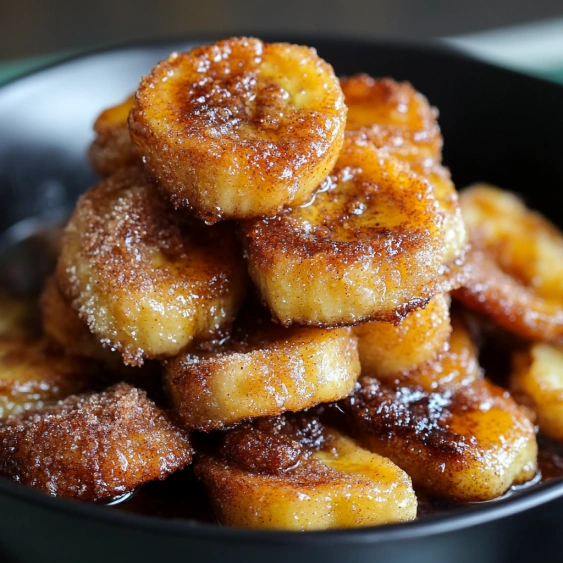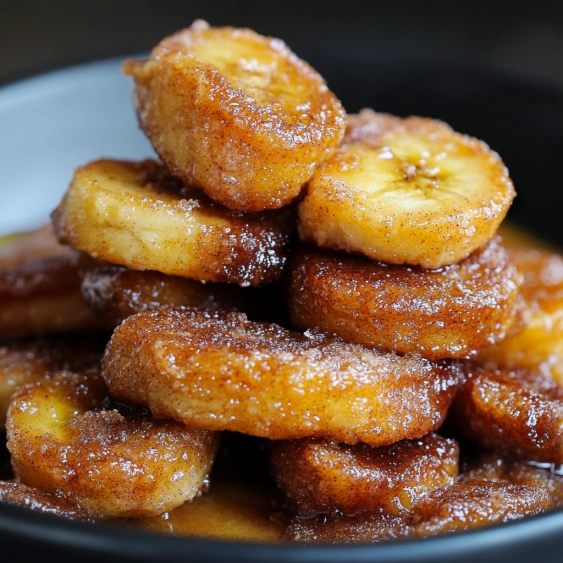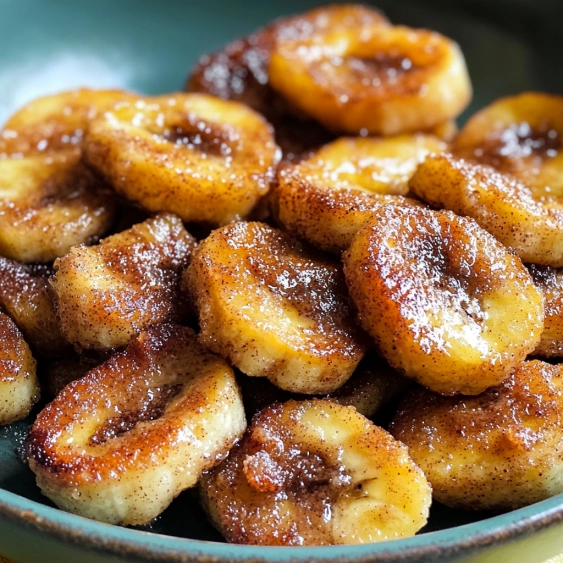 Pin it
Pin it
This sweet, caramelized pan-fried cinnamon banana recipe transforms ordinary bananas into a decadent treat in just minutes. Perfect as a quick dessert or to elevate your breakfast, these warm, cinnamon-spiced bananas create a restaurant-quality finish to any meal without complicated techniques or hard-to-find ingredients.
I discovered this recipe when looking for a way to use up overripe bananas without making banana bread again. Now it's my go-to impressive dessert when guests drop by unexpectedly or when I need to satisfy my sweet tooth without much effort.
Ingredients
- Bananas: Sliced into 1/2-inch pieces. Choose bananas that are ripe but still firm. Overly soft bananas will turn mushy during cooking.
- Cinnamon: Adds that perfect warm spice note. Fresh ground cinnamon offers the most vibrant flavor.
- Butter: Creates the rich caramelization. Unsalted butter works best to control the saltiness.
- Honey: Preferably raw, adds natural sweetness and helps create that gorgeous caramel coating. Raw honey provides more complex flavor notes.
Step-by-Step Instructions
- Prepare the Sweet Base:
- Combine cinnamon, butter, and honey in a medium frying pan over medium-high heat. Stir continuously until the butter completely melts and all ingredients form a smooth, fragrant mixture. This critical step creates the caramelizing agent that will transform your bananas from ordinary to extraordinary.
- Cook First Side:
- Add banana slices to the pan, arranging them in a single layer without overcrowding. Allow them to cook undisturbed for approximately 4 minutes. Patience is key here. You want the bottoms to develop a rich golden brown color. Watch closely as the bananas begin to caramelize.
- Flip and Finish:
- Carefully flip each banana slice using a spatula. The first side should display a beautiful caramelized appearance. Cook for another 4 minutes until the second side matches the first with its golden hue. The bananas should be tender but not mushy.
- Serve Immediately:
- Remove the bananas from the pan promptly to prevent overcooking. Serve while still hot to experience the full contrast between the caramelized exterior and warm, soft interior. These are magnificent over ice cream, yogurt, pancakes, or French toast.
 Pin it
Pin it
The cinnamon in this recipe brings back memories of Sunday mornings at my grandmother's house. She would make cinnamon toast for me as a special treat, and this recipe captures that same comforting aroma but with an elevated twist that makes it feel special enough for company.
Choosing the Right Bananas
The ripeness of your bananas significantly impacts the final result of this recipe. For ideal caramelization, look for bananas that have just turned yellow with small brown spots. These will be sweet enough to complement the cinnamon and honey while still maintaining structural integrity during cooking. Bananas that are too green will remain firm and lack sweetness, while overly spotted bananas might break down too quickly in the pan, creating a mushier texture. If you only have very ripe bananas, reduce the cooking time by about a minute on each side.
Make It Your Own
This recipe welcomes customization based on your preferences or what's available in your pantry. For a more indulgent version, sprinkle brown sugar instead of honey for a deeper caramel flavor. Add a pinch of nutmeg or cardamom alongside the cinnamon for more complex spice notes. For a touch of elegance, finish with a splash of rum or bourbon added to the pan just before serving (allow the alcohol to cook off for about 30 seconds). During summer months, these bananas make an incredible topping for grilled pound cake with a scoop of vanilla ice cream.
Nutritional Benefits
Beyond being delicious, these cinnamon bananas offer nutritional advantages over typical desserts. Bananas provide potassium, vitamin B6, and fiber, making this a treat you can feel good about serving. The natural sweetness means you need less added sugar, and cinnamon has been associated with blood sugar regulation. When served over Greek yogurt for breakfast, these bananas create a balanced morning meal with protein and carbohydrates to fuel your day. For children, this recipe offers a way to incorporate fruit in a form they'll eagerly devour.
 Pin it
Pin it
Frequently Asked Questions
- → What type of bananas work best for this dish?
Ripe but still firm bananas work best for this dish. They should be yellow with few brown spots. Overly ripe bananas will become too soft when cooked, while underripe bananas won't have enough natural sweetness to complement the caramelization process.
- → Can I use a substitute for honey in this recipe?
Yes, maple syrup, agave nectar, or brown sugar can be substituted for honey in equal amounts. Each alternative will add a slightly different flavor profile to the final dish, with maple syrup offering a deeper, woodsy sweetness and brown sugar providing more caramel notes.
- → How can I tell when the bananas are properly cooked?
Properly cooked bananas will have a golden brown exterior on both sides and will be slightly softened but not mushy. The caramelized coating should look glossy and have a slightly sticky texture. If the bananas are browning too quickly, reduce the heat slightly.
- → Can I add other spices besides cinnamon?
Absolutely! Consider adding a pinch of nutmeg, cardamom, ginger, or allspice to complement the cinnamon. A tiny amount of vanilla extract added to the butter mixture can also enhance the flavor profile. Experiment with small amounts of these additions to find your preferred flavor combination.
- → How long do pan-fried cinnamon bananas keep?
Pan-fried cinnamon bananas are best enjoyed immediately after cooking when they're warm and have the perfect texture. While they can be stored in an airtight container in the refrigerator for up to 24 hours, they will soften considerably and lose their caramelized texture. Gentle reheating in a skillet can help restore some of the original texture.
- → What are some creative ways to serve these caramelized bananas?
Beyond the suggestions of topping ice cream, yogurt, pancakes, or French toast, try serving them over oatmeal, as a filling for crepes, layered in parfaits, or even as a topping for grilled pound cake. They also pair wonderfully with a dollop of peanut butter on toast or can be served alongside waffles with a sprinkle of chopped nuts for added texture.
